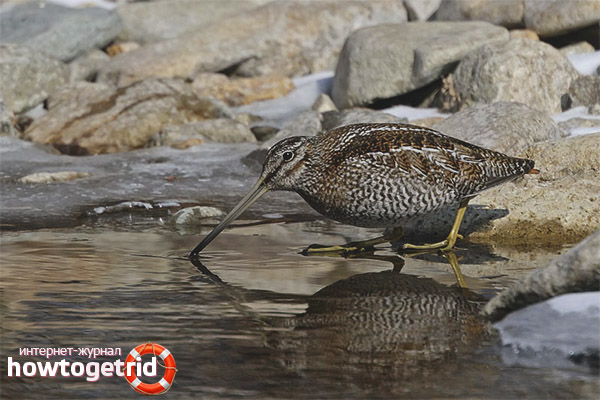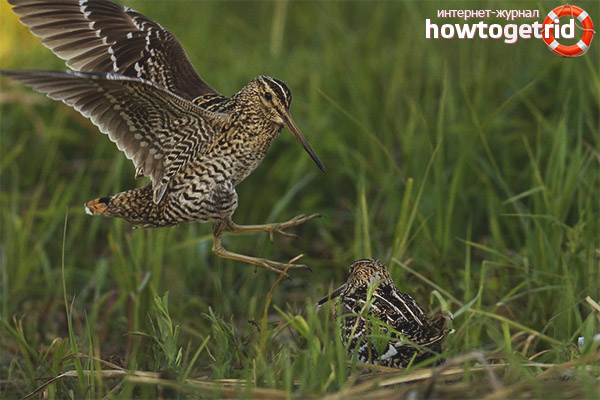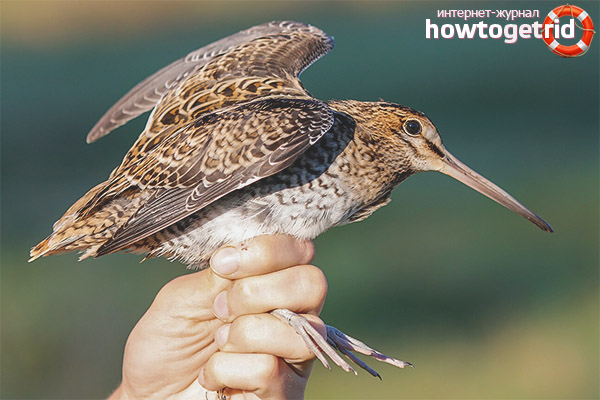The content of the article
The snipe bird belongs to the family of snipe. They, like other snipe, prefer to settle in wet biotopes. A distinctive feature of the appearance are long legs, as well as a long beak. These features help the appearance of the bird in the search for food.
The family has 21 genus of birds. Interestingly, in German, the name of the snipe is Doppelschnepfe. It is from this word that it came. The species is described by the scientist Lazam. Entries are dated 1787 year.
Habitats
Birds, which belong to the genus of snipe, live practically across the globe. You can not meet them only in Australia and Antarctica. But representatives of the type of snipe live only in Eurasia. You can see this bird from the north of Scandinavia to Siberia. They also live in Central Europe, but there are very few representatives of the species. A small number of birds also live in Asia.They can be seen on the territory of Palestine, Mesopotamia, and India. In the CIS countries inhabited by the forest snipe. This species is related to the snipe.
Birds are migratory, in the fall they fly to the territory of Africa. They winter in the central and southern parts of the continent. Sometimes the snipe is left to winter in the Mediterranean or in the British Isles. They return to their nesting sites in the second half of spring or early summer.
Like all representatives of the snipe, they live in the marshland, as well as in the meadows covered with low vegetation. Sometimes they can settle also on the banks of rivers. Prefer places with high humidity.
Appearance description
These birds are very often confused with snipe, which is a related species.But, if you look closely, you can see a lot of differences. Snipe has a much denser physique. Their beak is more powerful, shorter. The neck of this bird is also shorter than that of a snipe.
Representatives of the species have variegated plumage. From above the body is brown, from below it is lighter, covered with dark spots. Between the eyes is a dark strip that starts from the beak. On broad feathers of a bird strips of contrast white color are looked through. Their tail feathers are wide, asymmetrical. In shape and size, these feathers are similar to snipe tail feathers. But the snipe has more feathers.
The motley color of these birds allows you to perfectly hide from the enemy. When a bird is on the grass or in reed thickets, it is very difficult to notice it against the background of such an area. Juveniles have almost the same color as adults. The only difference is that young individuals at the extreme steering feather have a pattern that applies to almost all feathers, and in adults the upper part of the same feather has a white color.
Nutrition

These birds can eat both vegetable and animal food. Their favorite delicacy is earthworms, various shellfish of small sizes. They get them, digging in the soft peat with their beak. They also love insects and their larvae.Among the plant foods in their diet are the seeds of various plants, as well as wheat grains. In autumn, they can be found on potato or wheat fields. In the summer they are looking for food on the clover plantations.
They feed in the morning before sunrise or in the evening before sunset. Activity manifest at night or at dusk. They are very shy, therefore, as soon as they hear any extraneous sound, they soar sharply, flapping their wings.
The snipe fly at a height of about 3 to 5 meters above the ground. This height is relatively small compared to other birds. In flight, quacking sounds are made. Having flown 30-50 m, the bird usually descends to the ground. But, if she is frightened and wants to escape from danger, she can fly 300 meters or more. This happens when she hears shots of a hunter. But the hunter is not difficult to catch the snipe, because the bird flies not very high and straight.
They molt twice a year. One molt occurs in the spring, the second - in the middle of summer. In July, the great snipe begin to accumulate fat. As a result, the bird becomes clumsy, it is quite difficult to move. But by the time you have to fly away for the winter, all the accumulated fat is gone. They fly away already thin, and having arrived on the territory of Africa, become absolutely tiny.Going to wintering, they do not gather in flocks, but fly one by one. This feature also distinguishes the snipe from many other species of birds.
Breeding
As soon as the birds return to their nesting sites, the mating season begins immediately. Overcurrent occurs on the surface of the earth. First, the females fly there. They start singing in order to attract partners. They do not change the place of tokens, arriving each year for the same thing. When males fly to singing females, they in turn begin to attract their attention. To interest the female, he fluffs his tail, starts walking around, making knocking sounds. The male takes various interesting poses. Sometimes, to achieve the location of the female, they arrange battles among themselves. Already in the morning couples form and fly away. They choose a partner only for one season, as the species belongs to polygamous. Next year, the birds will choose their new partner.
Mating begins in mid or late May. The female begins to build a nest. The male is not involved in this process. They find a safe place, for example,under shrubs or in tall grass so that the nest is least noticeable to predators. Females make a small hole, which is lined with grass.
The hollows are usually laid in 4 eggs each. Sometimes eggs can be smaller. They are pear-shaped, painted in a dirty-brown shade. During the year they lay eggs only once. But sometimes the nest is destroyed by predators. Then the female can lay eggs again. The duration of incubation is about 3 weeks. After two weeks, the chicks begin to overgrow feathers. Mother cares for them for about one and a half months. Already at the age of three weeks they learn to fly. At the age of 6-7 weeks reach the size of adult birds.
Hunting
To find the snipe on the site, it is necessary to carefully examine it. When a hunter finds one bird, he is sure that there will be several more nearby.Hunting them is more convenient than many other birds. When the bird hears a slight rustling, it will not immediately take off. Before the dogs they are hiding. This allows the hunter to come closer. The disadvantage is that the dog does not always scare the bird so as to make it fly.
It is not difficult to shoot the snipe. They fly straight, not rising high into the sky. Even a novice can catch about 10 of these birds at a time. The main thing - to find a place where they live. Finding one bird, somewhere near the hunter will find more.
Interesting Facts
The researchers found that representatives of this species are the fastest compared with the rest of migratory birds. They are able to fly at a speed of about 100 km / h. When they fly long distances, they do not sink to the ground.
- People call snipe differently. Sometimes you can hear names such as couch, silent or white buyer.
- In recent years, the number of snipe has begun to decline sharply. Experts believe that the view is already close to the threat. Therefore, perhaps, the hunt for them will soon be banned. The decrease in the number associated with human activities.
- During the token period, they become careless. As a result, a predator or a person may be allowed close to him.
- In the photo they are extremely difficult to distinguish from woodcock or snipe. Consider the difference can only specialist.
Video: Great Snipe (Gallinago media)













To send